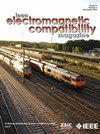偶极子与对数周期天线衬垫屏蔽效能特性的FDTD仿真与实验比较研究
IF 2.5
3区 计算机科学
Q3 ENGINEERING, ELECTRICAL & ELECTRONIC
IEEE Transactions on Electromagnetic Compatibility
Pub Date : 2025-02-19
DOI:10.1109/TEMC.2025.3531946
引用次数: 0
摘要
本文采用调谐偶极天线(IEEE标准299)或对数周期天线(MIL DTL 83528 G),根据相关标准中概述的规范,对衬垫屏蔽效能的表征进行了比较分析。我们的研究结合了使用时域有限差分求解器的三维全波模拟和200 MHz-1 GHz频率范围内的实验验证。在仿真中,利用代表外部天线的近场传感器来评估垫片在不同角度和位置的屏蔽性能。此外,仿真还探讨了采用两种天线时屏蔽效能的变化。在实验装置中,仅考虑0$^{\circ}$的撞击角来计算垫片的屏蔽效能。该研究证明了数值模拟和实验验证之间的良好相关性,揭示了调谐偶极子天线和对数周期天线在屏蔽效能方面表现出相似的行为。最后,本文强调,尽管IEEE标准299中建议使用调谐偶极子天线,但由于其易于使用和实用的角度,对数周期天线也可以同等地使用。本文章由计算机程序翻译,如有差异,请以英文原文为准。
FDTD Simulation and Experimental Comparative Study of a Gasket's Shielding Effectiveness Characterization: Dipole Vs. Log-Periodic Antenna
This article presents a comparative analysis of the characterization of the shielding effectiveness of gaskets using either a tuned dipole antenna (IEEE Std. 299) or a log-periodic antenna (MIL DTL 83528 G), following the specifications outlined in the relevant standards. Our study integrates both 3-D full-wave simulations using the finite-difference-time-domain solver and experimental validation within the frequency range of 200 MHz–1 GHz. In the simulations, near-field sensors representing external antennas were utilized to assess the gasket's shielding performance at various angles and locations. Additionally, the simulations explored the variability in shielding effectiveness when employing both antennas. For the experimental set-up, only the impinging angle of 0$^{\circ }$
求助全文
通过发布文献求助,成功后即可免费获取论文全文。
去求助
来源期刊
CiteScore
4.80
自引率
19.00%
发文量
235
审稿时长
2.3 months
期刊介绍:
IEEE Transactions on Electromagnetic Compatibility publishes original and significant contributions related to all disciplines of electromagnetic compatibility (EMC) and relevant methods to predict, assess and prevent electromagnetic interference (EMI) and increase device/product immunity. The scope of the publication includes, but is not limited to Electromagnetic Environments; Interference Control; EMC and EMI Modeling; High Power Electromagnetics; EMC Standards, Methods of EMC Measurements; Computational Electromagnetics and Signal and Power Integrity, as applied or directly related to Electromagnetic Compatibility problems; Transmission Lines; Electrostatic Discharge and Lightning Effects; EMC in Wireless and Optical Technologies; EMC in Printed Circuit Board and System Design.

 求助内容:
求助内容: 应助结果提醒方式:
应助结果提醒方式:


